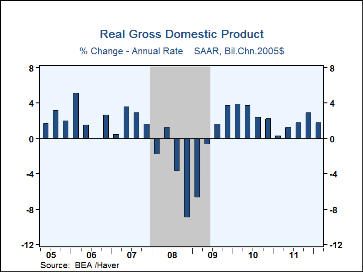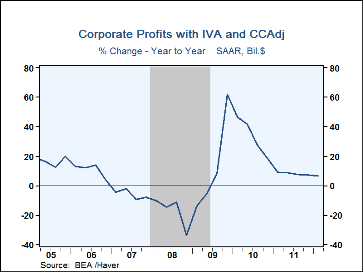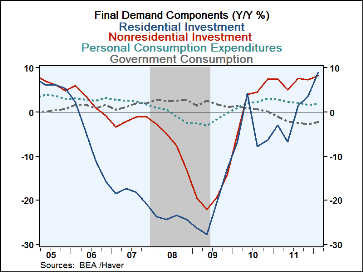 Global| May 31 2012
Global| May 31 2012U.S. GDP Growth Is Revised Down; Profits Tick Higher
by:Tom Moeller
|in:Economy in Brief
Summary
GDP growth last quarter was more disappointing than initially estimated. Growth was revised down to 1.9% (SAAR) from 2.2% and it was the weakest advance since Q3'11. The figure matched Consensus estimates. The highest expected gain [...]
GDP growth last quarter was more disappointing than initially estimated. Growth was revised down to 1.9% (SAAR) from 2.2% and it was the weakest advance since Q3'11. The figure matched Consensus estimates. The highest expected gain was 2.2%. Despite the disappointment, during the last four quarters growth of 2.0% was the swiftest since Q1'11.
Released for the first time, corporate profits nudged up 0.6% (6.5% y/y), roughly the same as during Q4. Profits in domestic financial industries rose 4.5% (1.2% y/y) while profits from nonfinancial industries ticked up just 0.6% (13.4% y/y). From abroad, corporate earnings fell 3.8% (-4.1% y/y).
A reduced estimate of inventory building's contribution to growth, to 0.2 percentage points from 0.6 points, had the largest effect lowering GDP growth last quarter. Foreign trade also subtracted marginally more as exports grew at a 7.2% rate (4.5% y/y) and imports rose 6.1% (3.1% y/y).
On the demand side, an upward revision to business investment growth to 1.9% (8.2% y/y) was accompanied by negligible revisions elsewhere. Growth in PCE was lessened to 2.7% (1.8% y/y) and government spending growth was a more-negative 3.9% (-2.3% y/y). Growth in residential investment was raised to 19.3% (8.9% y/y) as warm temperatures fueled growth.
Price inflation as measured by the chain-weight price index was raised slightly to 1.7% (1.9% y/y).
The latest GDP figures can be found in Haver's USECON and USNA databases; USNA contains basically all of the Bureau of Economic Analysis' detail on the national accounts, including the new integrated economics accounts and the recently added GDP data for U.S. Territories. The Consensus estimates can be found in AS1REPNA.
| Chained 2005 $,% AR | Q1'12 (2nd Estimate) |
Q1'12 (Adv) |
Q4'11 | Q3'11 | Q1'12 Y/Y |
2011 | 2010 | 2009 |
|---|---|---|---|---|---|---|---|---|
| Gross Domestic Product | 1.9 | 2.2 | 3.0 | 1.8 | 2.0 | 1.7 | 3.0 | -3.5 |
| Inventory Effect | 0.2 | 0.6 | 1.8 | -1.4 | 0.1 | -0.2 | 1.6 | -0.9 |
| Final Sales | 1.7 | 1.6 | 1.1 | 3.2 | 1.9 | 1.9 | 1.4 | -2.6 |
| Foreign Trade Effect | -0.1 | -0.0 | -0.3 | 0.4 | 0.1 | 0.1 | -0.4 | 1.0 |
| Domestic Final Sales | 1.7 | 1.6 | 1.3 | 2.7 | 1.8 | 1.8 | 1.8 | -3.6 |
| Demand Components | ||||||||
| Personal Consumption | 2.7 | 2.9 | 2.1 | 1.7 | 1.8 | 2.2 | 2.0 | -1.9 |
| Business Fixed Investment | 1.9 | -2.1 | 5.2 | 15.7 | 8.2 | 8.8 | 4.4 | -17.9 |
| Residential Investment | 19.3 | 19.0 | 11.7 | 1.2 | 8.9 | -1.3 | -4.3 | -22.2 |
| Government Spending | -3.9 | -3.0 | -4.1 | -0.1 | -2.3 | -2.1 | 0.7 | 1.7 |
| Chain-Type Price Index | ||||||||
| GDP | 1.7 | 1.5 | 0.9 | 2.6 | 1.9 | 2.1 | 1.2 | 1.1 |
| Final Sales of Domestic Product | 1.7 | 1.5 | 0.9 | 2.6 | 1.9 | 2.1 | 1.2 | 1.0 |
| Final Sales to Domestic Purchasers | 2.5 | 2.4 | 1.1 | 2.0 | 2.2 | 2.5 | 1.5 | -0.1 |
Tom Moeller
AuthorMore in Author Profile »Prior to joining Haver Analytics in 2000, Mr. Moeller worked as the Economist at Chancellor Capital Management from 1985 to 1999. There, he developed comprehensive economic forecasts and interpreted economic data for equity and fixed income portfolio managers. Also at Chancellor, Mr. Moeller worked as an equity analyst and was responsible for researching and rating companies in the economically sensitive automobile and housing industries for investment in Chancellor’s equity portfolio. Prior to joining Chancellor, Mr. Moeller was an Economist at Citibank from 1979 to 1984. He also analyzed pricing behavior in the metals industry for the Council on Wage and Price Stability in Washington, D.C. In 1999, Mr. Moeller received the award for most accurate forecast from the Forecasters' Club of New York. From 1990 to 1992 he was President of the New York Association for Business Economists. Mr. Moeller earned an M.B.A. in Finance from Fordham University, where he graduated in 1987. He holds a Bachelor of Arts in Economics from George Washington University.










